|
| August 1969, the war was still grinding away in the Central Highlands and I Corps, but the southern part of South Vietnam was eerily quiet. The Engineers were concentrating on land clearing and road building. I directed the installation of a pontoon bridge to replace a bridge destroyed by the VC on the highway from Bien Hoa to Vung Tau and flew combat supply missions with my friend George Coppage in his C-123. I visited a remote MACV Camp to check on a well drilling mission, and there was a change of command at the 159th Engineer Group.
Building Bridges
50 years ago, at 0200 hours, Sunday, August 3, 1969, the Viet Cong blew up a 104-foot span of the bridge across Rach Hoa on the main highway QL-15 between Saigon and Vung Tau. The explosion alerted a nearby jointly operated U.S. and Vietnamese operations center in Baria.
After a recon team from Baria observed the situation, the 1st Australian Task Force in Nui Dat, 4 miles from the bridge was alerted to restore the bridge. Lacking material and equipment for bridging, the Australians sought assistance from U.S. Army Engineers at Long Binh. The assemblage and transportation of equipment and technical advisors from several engineer organizations was coordinated by 1Lt Tom Butt, who happened to be the duty officer that Sunday. Thirty-five hours after the blast, the road was reopened to traffic using a 206-foot floating pontoon bridge.
The bridge destruction may have been related to the targets of Operation Camden, an Australian Army in support of the 501 Land Clearing Company, United States Army Corps of Engineers who were undertaking land clearing operations in the Hat Dich area. A large contact took place on 21 August 1969 during Operation Camden south of the Hat Dich Secret Zone in Phuoc Tuy Province against Viet Cong forces. The battle was fought between 3 Platoon and the Assault Pioneer Platoon of the 5th Battalion, Royal Australian Regiment (5RAR) and the Viet Cong 3rd Battalion, 274th Regiment
Following is an excerpt from my duty log, which runs from 1100 to 2400, 13 hours: (Some acronyms: FB = Float Bridge. MSR=Military Supply Route. IIFFV = 2nd Field Force, Vietnam. H8 = Helipad 8.)
Sunday, August 3, 1969
Daily Journal, S3 Section, HHC 159th Engineer Group, Long Binh, Vietnam
Entries by LT Thomas K. Butt, S3 Duty Officer
1100: Call from LT Robertson, 20th Engineer Bde - O3 Mission 287-5828-0-20 support Australian Engr Task Force at damaged bridge site, QL-15, YS 383592 by supplying 225' of float bridge and technical assistance as required. Contact COL Johnson NUI DAT 922-2953 ASAP. CB Mission: 212-5829-0-20: Open and maintain Route MSR Zink. Contact MAJ York 1st DIV ADE ASAP.
1103: SGT Slatter, Australian Task Force, 922-3953: Inquired what supporting equipment was available on site or available. SGT Slatter stated that an air compressor was available, but he wasn't certain about cranes or boats. Informed him that mission would be assigned to 100th Engr Co (FB) who would contact him shortly.
1105: SFC Stewart, 100th Engr. Co. (FB) - Notified of 03 mission. Requested they begin loading trucks immediately and check status of bridge erection boats.
1125: COL O'Sullivan, IIFFV - Inquired as to the status of the Bridge mission and requested we move the bridging out ASAP. Verify that sufficient cranes and possibly boats were on site. IIFFV chopper will leave red carpet pad at 1300 for bridge site. I requested two seats for personnel from 100th Engr Co (FB) to make recon. Notified SFC Stewart.
1210: MSG Sanders, 46th Engr Bn - I requested crane to be moved ASAP to 100th Engr Co (FB) bridge yard to load bridging. MSG Sanders stated it would be here by 1300.
1250: CPT Lilygren, 92nd Engr Bn - Only one Port Construction boat is operational and is at Ong Thin. Earliest possible time to move to Long Binh would be tomorrow morning.
1300: SFC Stewart, 100th Engr Co (FB) - Notified that 100th Engr Co (FB) boats would have to be utilized. SFC Stewart stated that one would be repaired in time to leave with convoy and another would have to be taken from either Binh Loi or Phu Long. Requested he check operational status of the latter two boats and get the one that would be available sooner.
1400: MSG Sanders, 46th Engr Bn - Crane had not yet moved to support 100th Engr Co (FB) and would have to be re-rigged from a clamshell. I requested this be done and moved to 100th Engr Co (FB) yard ASAP.
1430: SFC Stewart - 100th Engr Co (FB), 1st serial of bridging departed 1425 hrs.
1600: SFC Stewart - 100th Engr Co (FB) - 2nd serial of bridging and one erection boat departed at 1600 hrs.
1745: MSG Schnake, 20th Engr Bde - 34th Engr Gp has been tasked to assist in bridge mission with crane and Mike Boat. We are to coordinate directly with them.
1750 CPT Brown, CO, 523rd Engr Co - Will check to see if Mike Boat is operational or if one can be borrowed. Will call back.
1830: CPT Brown, CO, 523rd Engr Co - Mike Boat and crane will be at ridge site approximately 2130 hrs.
1845: CPT Barker, 17th Royal Australian Engr Sqdn - Informed him of crane arrival time and asked him to inform LT Mercer.
1900: CPT Barker, 17th Royal Australian Engr Sqdn - Called with list of material that is needed at bridge site. Notified SFC Stewart to police up the material and load a truck.
1910: CPT Roth, 20th Engr Bde - Informed them of the need to transport material and requested air transportation.
1930: CPT Roth, 20th Engr Bde - Chopper will be laid on; we are to bring material to the helipad when loaded. 523rd Engr Co will supply cable and dunnage.
2000: CPT Barker, 17th Royal Australian Engr Sqdn - Australians can supply dunnage - contact CPT Taylor Vung Tau MU76 is to arrange convoy to site. Informed him of chopper supply mission and gave call sign, frequency and landing instructions.
2110: LT McDaniels, 20th Engr Bde - Gave him information on night landing pad at TS 383602 on the western side of QL-15 call sign RECON on 38.50.
2300: LT McDaniels, 20th Engr Bde - Materials were delivered at site and chopper is returning to H8.
2400: Journal closed.
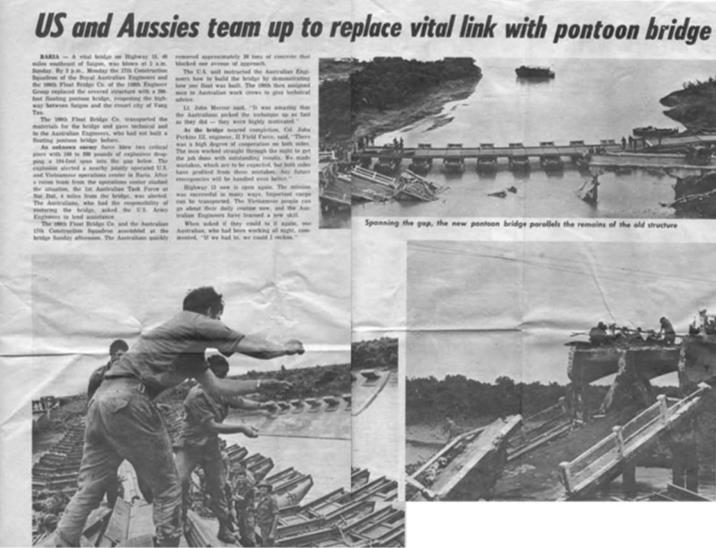
Figure 1 – Article from Stars and Stripes. Rach Hoa bridge, between Saigon and Vung Tau, was blown by the VC on August 3, 1969. The 100th Bridge Company provided bridge components, and the temporary float bridge was constructed by the 17th Construction Squadron, Royal Australian Engineers
Following is a letter to my parents of August 14, 1969:
14 August, 1969 – Long Binh
Dear Folks,
Aside from the fact of being so busy, I’ve been putting off writing because I keep thinking I can get a phone call through, but Paul has been hard to find lately. He was in the hospital for a while and now they say he’s on R&R. He started working the night shift anyway, which is the busiest time of day – and even when I could get him, he couldn’t get a free circuit.
My job is starting to slow up a little finally. Got a new major in about 1 ½ weeks ago, and he is just about trained. I’ve been trying to slip inconspicuously back into my old position with only limited success, but I’ve still got more free time than I’ve had in two months.
George Coppage was down yesterday and today, and I tried to give him a Cook’s tour of Saigon in one night. He’s only got about 1 ½ months to go with three trips to Taiwan lined up to make it even shorter. Last Sunday, I flew up to Phan Rang with him – and drove the plane some. The air base here is really plush compared with anything in the United States and makes the army facilities look like a slum in comparison.
I picked an unfortunate day to come back, as I was caught in Tan Son Nhut during the currency exchange. About every 8 or 10 months on a secret day, they lock everybody on base in Vietnam and make them change their MPC for a different issue. The idea is to limit black marketing, which is primarily transacted in MPC. Several million dollars in MPC is instantly invalidated because it is held by Vietnamese who cannot turn it in. Saigon looks kind of like the stock market crash of ’29 when this happens – people jumping out windows and all that. My two buddies collected over $5,000 in MPC from Vietnamese on Monday before they went to work – and were able to exchange $1,000 of it – all profit! Anyway .. I flew into Tan Son Nhut and they wouldn’t let me out until I changed my money. The line for transients was ½ mile long, so I finally got on a chopper and flew back out to Long Binh – after waiting in line 4 hours and moving about 4 feet.
I took George over to Bien Hoa Air Base to catch a flight back to Phan Rang, and we ran into Murray Green, who used to room with Randy Snapp at Yellowstone, who is now a pilot. Also ran into Mike Thomas, an old Sigma Nu from Hot Springs, who is with the 11th Armored Cav over by Cambodia.
Finally got all my sound equipment with the purchase last week of a tuner/amp and speakers. I now have a TEAC 4010S tape deck, Sansui 3000 tuner/amplifier and a 2-Sansui 2000 (70 watter) speakers. Cost here $550 and worth about $1,000 in the states. The only other major investment “I’m going to make is some Hong Kong suits from the friendly tailor – and then maybe I can think about saving some money. I’m still trying to get that catalog form PACEX, but I’m not having any luck. I expect a breakthrough any day, however.
I signed up for R&R to Sydney on 5 November, which will put me there for some good beach action. Through some administrative foul up, I owe the army about 5 days leave, so I don’t think I can pull a leave while I’m over here.
Other than what’s happened this week, there is little to relate. I’ve been too busy to get out anywhere – and only Saigon once or twice a week. I took my first day off in two months when I went to see Coppage. The war is real quiet here except for a few minor incidents. There have been some big indications lately of the projected pull-out continuing. We were ordered to cease all base construction projects less than 90% complete. The lumber supply has been almost depleted and apparently there is no more coming in-country. What is left is all going to combat and operational support (bunkers, minimum requirements, revetments, etc.).
The big mission of the engineers from now on out will be jungle clearing and highway construction, both of which have probably done more to “win” the war than any amount of combat. By this time next year, our group will be almost totally committed to highway construction, and the 79th group entirely committed to land clearing – if they are in fact here or partly here.
I don’t know whether you heard or not – but Joe Butt got transferred up here when his 9th Division unit went home. He’s now the XO at the 12th Aviation Group here on Long Binh and has been properly initiated into the better things of Vietnam life which are available in Saigon and not in the Delta mud – what a change for an infantry platoon leader used to living with his feet underwater.
I’m curious if Martin and Nancy have gone home yet, and what it was that made them leave such a seemingly groovy situation. Tell Martin to write me and fill me in when they get back. I wish I could pull up stakes and tour around for a while – I don’t mind Vietnam at all, but the work is really getting old.
Send me the Razorback clippings when football season starts.
Love, Tom
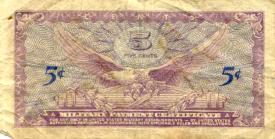 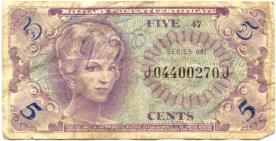

As explanation to the reader, some of the people I have referred to in my letters include:
- Jack Butt – my brother 6 years younger, attending the University of Virginia
- Martin Butt – my brother, 3 years younger, who had been a Marine, served in Vietnam, decorated with a Purple Heart, returned to the University of Arkansas, and married Nancy Stair.
- John Backus – a contemporary from Fayetteville who had also gone thorugh Army ROTC and was serving comtemporaneously in Vietnam in an armored reconnaisance outfit.
- George Coppage - a contemporary from Fayetteville who had also gone through Air Force ROTC and was serving comtemporaneously in Vietnam as a C- 123 pilot, stationed at Phan Rang.
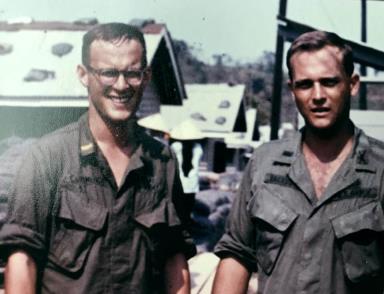

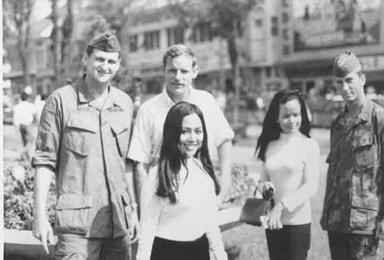
Figure 4 - Murray Green, Tom Butt and unidentified friend of Murray’s with Saigon girls
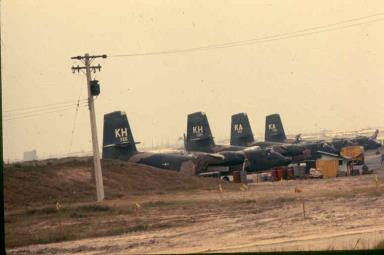

- Murray Green – I met Murray in Yellowstone Park in 1965 when I was working for the National Park Service as a Student Trainee Architect. Murray was a seasonal Park Ranger. At the end of the summer, we left together driving home in Murray’s car – Murray, me and a girl whose name I cannot remember. Murray was from Mississippi. He had recently purchased a .22 pistol, and we somehow began stopping frequently in the Wyoming wilderness for “quick draw’ contests. I think we were trying to impress the girl. At any rate, Murray was a little too quick on the draw and shot himself through the leg. We treated him with whiskey until we could get to the first town in Wyoming big enough to have a hospital, where they extracted the bullet and patched him up. I next ran into Murray in Vietnam, where he was a C130 pilot for the “Ranchhands,” who were spraying Agent Orange over Vietnam.
- Bill Dorn – Bill Dorn was George Coppage’s roommate in Phan Rang and a C-123 pilot. Later, Dorn lived with me and several other people in Mill Valley in 1970 – 71 when he was flying C-141’s out of Travis Air Force Base.
The Vietnam War, as seen on Ken Burns’ “Vietnam War” is focused mostly on combat of which there was plenty, of course. The sound effects are mostly gunfire and explosions. But for most of the nearly three million service members who served in Vietnam, life was mostly boredom punctuated by occasional danger and a lot of weird stuff.
Following are snippets from the experiences of several friends of mine that show the ironic and sometimes comical side of service in Vietnam
Eric Nelson, from Vermont, educated as an artist, drafted into the Army in 1968, retired as professor of art at Middlebury College in Vermont.
The U.S. Army actually assigned Eric to something he was good at. As an artist, he became an illustrator for psychological warfare (PSYOPS) media prepared in Saigon, flown to New York for printing, flown back to Vietnam, and finally dropped by planes and helicopters over areas where someone figured regretful Viet Cong would be persuaded to change their allegiance. Untold billions of those pamphlets and flyers were distributed during those war years. No one knows whether it did any good, or not. But for Eric, it was good duty.
One of the best stories I remember about Eric, who was a bit of a rogue, was his unauthorized visit to the “Coconut Monk,” a holy man based on an island (Con Phung) in the Mekong River between Ben Tre and My Tho. Ong Dao Dua, the monk, meditated on the island for three years during which time he ate nothing but coconuts. He headed his own sect, which was a bizarre mix of Christianity and Buddhism. About two weeks before his discharge, Eric asked his commanding officer for permission to make a trip to Con Phung. Because it was considered unsecure and dangerous, permission was denied.
Eric went anyway, and when he returned, he was busted to the lowest possible rank before leaving for home and leaving the Army, with a dubious reputation but with an honorable discharge.
Eric said the monk had two telephones flanking his seat, one white and the other black. When Eric asked what they were for, the monk responded, “One is a direct line to Ho Chi Minh, and the other a direct line to Richard Nixon.” He said he was in the process of brokering a peace agreement.
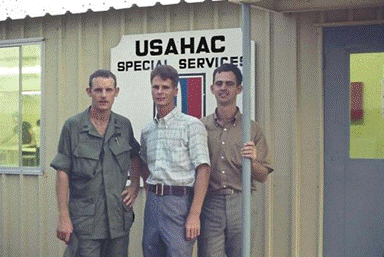
Figure 6 - Tom Butt, Eric Nelson and Alan Tolbert in Saigon 1969
Eric went on to become a respectable citizen, artist and academic. Recent exhibitions of his sculpture have been installed in public sculpture parks at James Madison University in Harrisonburg, Virginia; Navy Pier in Chicago; and the DeCordova Museum and Sculpture Park in Lincoln, Massachusetts. Nelson has been a visiting artist at the Edinburgh College of Art in Edinburgh, Scotland; the School of the Museum of Fine Arts in Boston; Trinity College in Hartford, Connecticut; and the Vermont Studio Center in Johnson, Vermont. He has been awarded residency fellowships at Moulin a Nef in Auvillar, France; the Virginia Center for the Creative Arts in Sweet Briar, Virginia; and Sculpture Space, Inc., in Utica, New York. He has received two fellowships from the Vermont Council on the Arts and the Albert Jacobson Memorial Award at the Silvermine Guild Arts Center in New Canaan, Connecticut.
For more, see http://www.tombutt.com/forum/2012/120401.htm.
Bill Dorn, from Texas, attended Texas A&M with a degree in Aerospace Engineering, Commissioned an Air Force Officer from ROTC, flew C-123s and C-141s in Vietnam, retired.
Bill reminds me of Yossarian in Catch-22. Bill recalled that on his way to Vietnam, he stopped over at Clark Air Force Base in the Philippines where all the pilots were required to take a week long escape and evasion and jungle survival course before going in-country. Bill is kind of a slow moving, tall and lanky guy and not one to get out front, so when he reported for jungle school, he was among the last to come into the assembly room and took a seat in the back. As the pilots lined up to check in, Bill was in the end of the line and found that by the time he got to the sign-up place, the course was full, and he was told to come back next week.
After a week of partying with stewardesses in the officers club, Bill reported again and this time made it a point to sit in the back of the room. Once again, the course filled up before he was able to sign up, and Bill was passed over. Back to the party.
By that time, he had the scam down. But after three weeks of delays and hard partying, his commander sent word that Dorn better finish jungle school and get to Phan Rang, or else.
Finally, Bill reported in to Phan Rang, as luck would have it, just before the Tet holiday in 1969. His first night was marked by a Viet Cong attack on the base that breached the wire and was repulsed only with a significant effort. When the rockets started coming in, he strapped on his only weapon, his pilot’s issue .38 and ran for the bunker barefoot in his skivvies. A great start.
Finally, Bill recalled the day his crew exceeded their maximum flying hours and were ordered to lay over on Vung Tau for the night instead of returning to Phan Rang. The entire crew got drunk and rowdy and were jailed by the MPs. Finally the wing commander tracked them down and sprung them just in time to take off for their next mission.
For more, see http://www.tombutt.com/forum/2012/120425b.htm
Bernard Horstmann, from Germany, Hong Kong and New York, drafted into the Army in 1968, retired, living in Munich
New York, 1968. Bernhard Horstmann was beginning a career as a 25-year old wine merchant living in New York City when he was drafted. As a German citizen, Bernhard didn’t have to serve; he could have simply returned to Germany.
But he decided to take the plunge. He quit his job, sold his car and moved out of his apartment, taking government provided transportation to Ft. Gordon, GA, to report for basic training.
At Ft. Gordon, he was summoned for an interview with an intelligence officer. Was he born in China? Yes. Had he ever traveled to East Germany? Yes he had. Was he a communist sympathizer? Of course not. Did he have a security clearance or other proof of non-communist sympathies? He did not.
Bernhard was excused and sent back to New York where he had to beg to get his job back and found temporary lodging in a cheap motel.
Just when things were getting back to some semblance of normal, Bernhard got a second draft notice. Apparently, the Army had investigated him and found him to be a thoroughly red-blooded American of German citizenship.
The last thing his boss advised him before he left again for Ft. Gordon was “Don’t ever volunteer for anything.”
Back to Ft. Gordon.
So, only a few days into basic training, it appears that the entire Army cooking staff had been snatched away for duty in Vietnam. “Anybody have cooking experience?” the drill sergeant asked. Forgetting the recent advice about volunteering, Bernhard stepped forward along with six others. Five of them described their meager experience with McDonald’s and other fast food restaurants, but Bernhard, wanting to set himself apart from the crowd, lied that he had been a sous-chef at the Waldorf Astoria.
Next thing he knew, he was in full charge of the mess hall. Bernhard actually had no professional cooking experience, but he found the Army had manuals with detailed recipes for everything. If you could read it, you could cook it.
So Bernhard spent his entire basic training as a chef. Never had KP; never went to the rifle range; never had to march.
He also took the standard proficiency test, scoring high with fluency in three languages and typing speed of 80 words per minute.
But the Army needed more soldiers in Vietnam, so Bernhard had to end his career as an Army chef and head into the unknown.
Now I have to back up here and provide some more context.
Bernhard was born in China to a mother who was the daughter of missionaries and a father who was a German banker. His mother’s father was Chinese. Just before the Communists took over in 1949, Bernhard’s parents divorced, and his mother, then single with four children, had to flee, ending up temporarily in Thailand.
Charlotte Horstmann eventually moved to Hong Kong, where Bernhard received his early schooling. Later, he attended boarding school in Germany while his mother became a highly successful dealer in Chinese antiquities in Hong Kong. Her shop was a “don’t miss” destination for stars, politicians, business magnates and high-ranking government officials from around the world. Click here for a 1982 article in the New York Times.
Eventually, Bernhard moved to New York, where we began this tale in 1968.
Now, back to Vietnam.
In 1969, Bernhard found himself at the replacement depot at Long Binh, sitting around waiting for something to happen. He remembered another piece of advice his boss gave him. “Always look busy doing something, or they will tap you for something you don’t want to do.” This time he took it. So Bernhard grabbed a broom and started cleaning up the depot. As his fellow soldiers lounging around were commandeered for combat duty, Bernhard worked even harder. A man with a mission.
Finally, he was the only one left, and a sergeant asked to see his 201 file. Struck by the 80 words per minute typing skill, the sergeant whisked Bernhard off to Saigon where he was assigned to some obscure unit that seemed to do nothing but create paperwork.
Now it came to pass that as various war correspondents, diplomats and other officials visited Charlotte’s (Bernard’s mother) shop in Hong Kong, she urged them to be sure and check on Bernhard when they passed through Saigon. Almost everybody important passed through Saigon in those days.
So it wasn’t long before the sergeant overseeing Bernhard’s paper mill got a phone call from the American Embassy. “Horstmann,” he yelled, “you have phone call.” No E4 got a phone call in those days. It turned out to be the ambassador with an invitation to an Embassy party. “Do you have a suit and tie,” the diplomat asked. Somehow, Bernhard found a suit and began a pattern of attending events and participating in social activities, including membership in the exclusive Circle Sportif Tennis Club, that any other E4 could not have imagined in his wildest dreams.
Resentment, however, began to build up with the lieutenant who commanded Bernhard’s unit, and Bernhard became the target of abuse. “What did you do then,” I asked Bernhard a few days ago when he was retelling this story.
“I called my mother.”
Bernhard was transferred to another unit and treated with more respect.
For more, see http://www.tombutt.com/forum/2012/121215e.html
Alan Tolbert, from Tennessee, graduated from University of Tennessee with a Master’s Degree in City Planning, drafted into the Army in 1968, retired.
Alan and I had been at Ft. Polk, LA, together in 1968. I was a basic combat training officer, and Alan was a trainee. Neither of us were enjoying our assignments.
It seems that in late 1968, there was a movement to make Ft. Polk a “permanent” installation. It had been built quickly in WWII as a sprawling training facility of mostly one and two-story wood frame buildings not expected to last more than five years. My father had been there briefly in WWII during the “Louisiana Maneuvers.” More than 20 years later, it was still buzzing with activity, having become known as the “last stop before to Vietnam.”
Becoming a “permanent” post would mean lots of money for the local economy and a boon to local politicians. Someone decided that the road to permanency required a “master plan team.” The word went out for architects, engineers and planners.
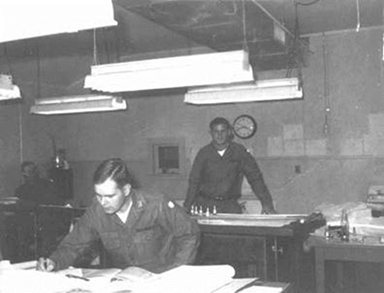
Figure 7 - Ft. Polk Master Plan Team hard at work
Alan Tolbert had a master’s degree in City Planning from the University of Tennessee, and, of course, I had a degree in architecture. We both applied and found ourselves part of the brand new Ft. Polk Master Plan Team. We had no idea what we were doing, but we were treated like
After a couple of months, we all got orders to Vietnam, but our civilian overseer was well-connected politically and informed the local congressman that our mission was vital to national defense, not to mention the future economy of central Louisiana and the congressman’s chances for reelection. Some kind of congressional action ensued (we were told it was an investigation), and our orders were postponed for three months.
Eventually, however, the needs of the war surpassed the need for Ft. Polk’s Master plan Team, and we all found ourselves in Southeast Asia.
Alan’s first assignment was quite a comedown. He was assigned to drive the jeep of a lieutenant who didn’t seem to have anything to but drive around the Saigon area. But Alan, ever alert for advancement opportunities, somehow got himself assigned to the mayor of Saigon as a city planner. No one seemed to know what he was supposed to do, but he was assigned an office and a secretary. He was also allowed to trade his uniform for civilian clothes.
Taking advantage of the apparent absence of a superior to report to in the organization chart of his murky assignment, Alan drew up a list of 30 plausible activities in which he could conceivably be engaging and gave them to his secretary. “If anyone calls or comes looking for me,” he told her, “go down the line to the next activity and tell them that is what I am doing today.” When the entire list had been exhausted, the idea was simply to start over. For example, Alan might be “inspecting bridges in Thu Duc” on Monday or “surveying traffic patterns in Binh Thanh” on Tuesday. Remember, this was in the days before cell phones, so no one could check. A modest gratuity to the secretary sealed her loyalty and made her a willing co-conspirator. Now, neither of them had any work they had to do.
But after a short time, no one even knew Alan was there or cared. No one came looking for him.
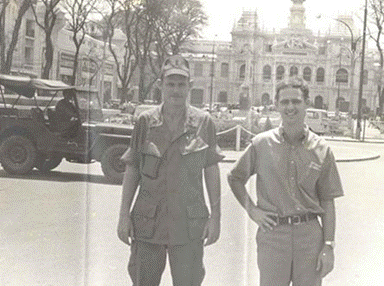
Figure 8 - Tom Butt and Alan Tolbert, Saigon, 1969
For the rest of his tour, Alan was a free agent. A reluctant “tourist” stuck in Saigon with no schedule and no responsibilities. With little money but an impressive job title, a gift of gab and nothing else to do, Alan gravitated to leisure class activities where he could meet interesting people.
When I later looked up Alan in Saigon, he and Bernhard, along with another friend, had pooled their money to rent a modest apartment where they could hang out and entertain.
The second letter home of August, 1969:
28 August 1969, Long Binh
Dear Folks,
Life has reached a more leisurely pace around here now that the new major is trained and I have settled back into my old routine. I only worked one night this week and actually took Sunday afternoon off – what a great feeling of freedom!
Coppage’s roommate was down for the weekend – we spent all afternoon at the Saigon Zoo ogling at girls. The zoo is a really well kept and interesting place and is kind of a weekend social center when the weather is nice. It reminds me a lot of Golden Gate Park in San Francisco – but it’s hard to find any hippies.
I’m wondering what Martin and Jack are up to but I really don’t know where to write them now. I guess when school starts I can get everyone’s location nailed down again. I’ve been running around with Joe Butt several times a week. Before he even came to the company he is in, we were doing some horse-trading with them. They’ve been lending us an electrician for our renovation for over a month, and we’ve been giving them some materials – just poured 2 transit mixers of concrete for a patio over there today. I guess the army would grind to a halt if it weren’t for the old do it yourself supply system. We haven’t been able to get office supplies for months through regular supply channels, but it’s amazing what a little gravel “for the colonel’s sidewalk” can do. We have a constant stream of scroungers in here with their own unique and always drawn out sob stories. Our gravel is always “very critical” and “for authorized projects only,” but we manage to shake a little loose every now and then.
I even got out of the office for the first time in weeks today – took a ride about 150 miles northeast of here to a MACV camp in a beautiful little valley surrounded by huge mountains. Beautiful flying weather, which is unusual for this time of year. The advisors are leading the good life up there – It looked like the only thing they had to fight was occasional boredom and too much sleep. The only purpose was to see if they still needed a well that was directed about 2 years ago. They allowed as how they could probably use it, so we came on back and put them on the well drilling list.
All base construction has virtually halted as a result by Gen. Mildren, CG, USARV. The shift in our effort for the next year will be road construction. Within a couple of months, our group will be operating 4 major quarries and 3 asphalt plants in an attempt to pave Vietnam before the engineers all leave. We’re getting all kinds of tremendous civilian road building equipment which is more efficient than the rugged military stuff. Our group will just be a giant highway contractor by the time I leave – 6 months left today!
I’m enclosing some newspaper stories and a copy of our daily log for a day earlier this month when we had to build a float bridge. It’s interesting to compare the journalist’s version with the log notes. I was the only officer in there that particular day and spent about 10 hours with a phone in each hand. Other than things like this that crop up once in a while, business is pretty routine.
I ran into another old Sigma Nu last week – Mike Garlington from El Dorado – used to have a band at the U of A. he got drafted and is working in Special Services in Saigon – making a few entertainment tours, etc. He got us in a good party last Saturday night where his group was playing … and the Saigon beat goes on.
Love, Tom
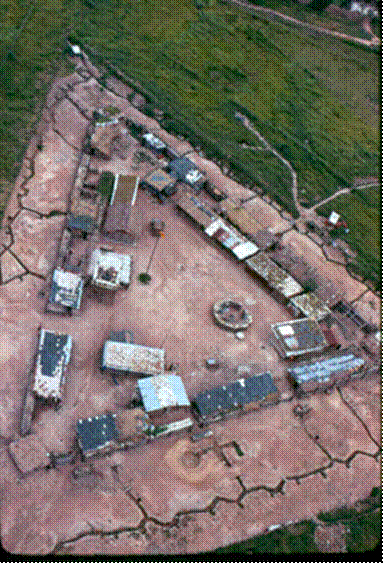

Change of Command
In August, 1969, Col. Joseph K. Bratton, later to become a lieutenant general and chief of engineers (highest ranking engineer in the Army), took over command of the 159th Engineer Group. For video, see https://www.youtube.com/watch?v=seWekT94JtI.
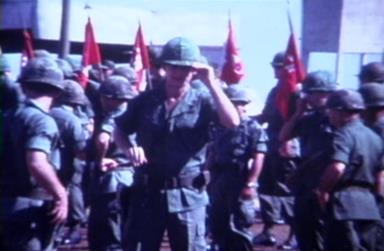

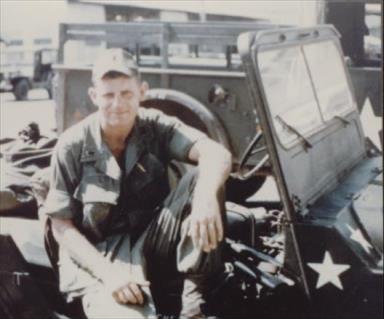

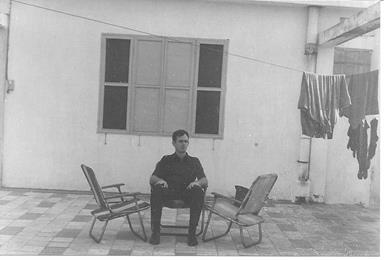

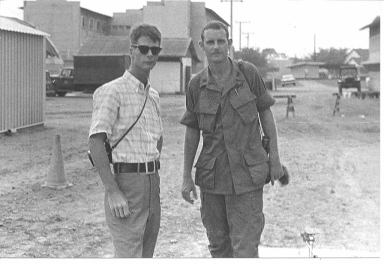
Figure 13 - Eric Nelson and Tom Butt in Saigon
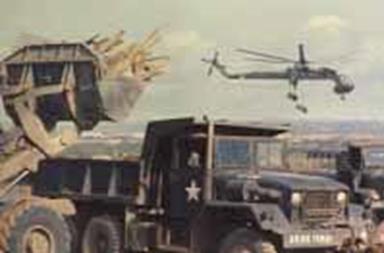

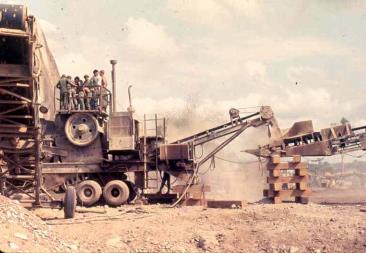

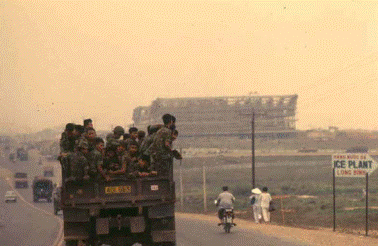

|

